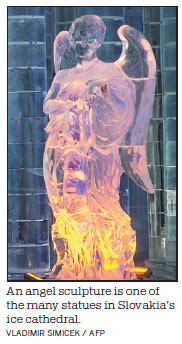Icy St. Peter's Basilica in Slovakia draws visitors closer to heavens
HREBIENOK, Slovakia - A young nun breathes deeply as she peers up at a statue of an angel bathed in softly colored light streaming through a church, and as she exhales, you can see her breath.
Instead of wood or bricks and mortar, this chilly house of worship perched among the snowy peaks of Slovakia's High Tatra Mountains has been built from massive crystal-clear blocks of ice.
At 1,285 meters above sea level, the ice replica of Saint Peter's Basilica in Rome is higher than any of Slovakia's 4,158 churches, more than half of them Roman Catholic.
Although it has not been consecrated, another visitor, Zlatica Janakova from southern Slovakia, says it feels like a real church.
"It's so good for your soul; it provides you with tranquillity," she whispers.
"All of nature is inside and around this temple," she adds, gazing at the surrounding alpine vistas.
Martin, an Englishman who declined to give his surname, describes it as a "beautiful, religious place, so peaceful and calm".
Since 2013, ice sculptors have flocked to the Slovak Tatra mountain hamlet of Hrebienok every winter to build a Tatra Ice Temple, or scaled-down replica of a famous church using only crystal-clear ice blocks.
This year, it's an 11-meter tall version of the 16th-century Vatican basilica, complete with the imposing two half-circle wings of Bernini's colonnade.
A quarter of a million tourists last year took the short funicular ride up the mountain to see the ice replica of Barcelona's soaring and intricate Sagrada Familia.
Sacred concerts
A team of 16 sculptors from Slovakia, Czech Republic, Poland, Wales and the United States worked 12 hours a day for a month to create this year's ice temple.
On Sundays, the venue vibrates with the sounds of sacred music concerts.
"I'm glad to see people crossing themselves and praying inside," says Slovak chief sculptor Adam Bakos.
The interior boasts sculptures modeled on the works of Italian masters side-by-side with those of chamois, marmots and other wildlife native to the High Tatras.
"I gave them a free hand with the decoration, so each artist added their signature style to the sculptures," Bakos said.
Slovak-Greek artist Achilleas Sdoukos designed and produced stained-glass decorations incorporated into the temple's icy walls.
The building material, namely 1,880 ice blocks weighing a total of 225 metric tons, was imported from neighboring Poland.
"We tried different suppliers, from the Netherlands, England, Norway and Hungary, but Polish ice seemed to have the highest quality, it really looks like glass if kept cold enough," says Rastislav Kromka, technical director of the Tatra Ice Temple.
Agence France-presse

(China Daily 03/13/2019 page7)


















